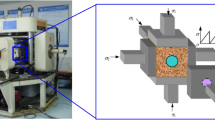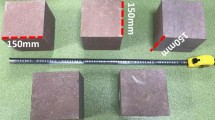Abstract
When a rock sample is extracted from an underground rock mass, it is subject to unloading, which will cause changes in the physical and mechanical properties. This article describes a laboratory experiment to determine the change of P-wave velocity of rock samples during a uniaxial compression test. It was found that the P-wave velocity vs. stress curves (V-S curves) of the rock samples could reflect three stages of bulk volume deformation commonly observed in a uniaxial compression test of rocks. When the applied stress was less than σ c (about 0.25–0.33 of the uniaxial compressive strength), the P-wave velocities increased rapidly with the increase of stress; this part of the V-S curves could be fitted with a power function. When the stress was greater than σ c, the P-wave velocities of rock samples increased more slowly and gradually approached the peak before decreasing dramatically near failure; the V-S curves above σ c could be fitted with a polynomial function of the second degree. During the V-S experiment, it could be also observed that the increasing rate of P-wave velocity decreased dramatically when the applied stress reached the overburden stress. An unloading index was defined as the ratio of the P-wave velocity under in situ overburden stress to the P-wave velocity at free stress and could be calculated from the measured V-S curves. Based on the calculated unloading index, the calculation of the intactness index of rock mass could be modified, and then an improvement of the basic quality (BQ) classification method of rock masses, which is used widely in China, was made.










Similar content being viewed by others
References
Bachman RT (1983) Elastic anisotropy in marine sedimentary rocks. J Geophys Res 88:539–545
Bian Z, Li W (1999) Research on engineering mechanics properties of rock foundation under second Changjiang bridge in Nanjing. J Yangtze River Sci Res Inst 16(4):42–45 (in Chinese)
Blake OO, Faulkner DR, Rietbrock A (2013) “The effect of varying damage history in crystalline rocks on the P- and S-wave velocity under hydrostatic confining pressure”. Pure Appl Geophys 170:493–505
Eslami J, Hoxha D, Grgic D (2012) Estimation of the damage of a porous limestone using continuous wave velocity measurements during uniaxial creep tests. Mech Mater 49:51–65
ISRM (1978) Commission on standardization of laboratory and field tests, suggested methods for determining sound velocity. Int J Rock Mech Min Sci Geomech Abstr 15:53–58
ISRM (1981) ISRM Suggested methods—rock characterization testing & monitoring. Pergamon Press, Oxford, pp 113–116
Ji S, Wang Q, Marcotte D et al (2007) P wave velocities, anisotropy and hysteresis in ultrahigh-pressure metamorphic rocks as a function of confining pressure. J Geophys Res 112:B09204. doi:10.1029/2006JB004867
Johnston JE, Christensen NI (1995) Seismic anisotropy of shales. J Geophys Res 100:5991–6003
Kahraman S (2001) Evaluation of simple methods for assessing the uniaxial compressive strength of rock. Int J Rock Mech Mining Sci 38:981–994
Karakul H, Ulusay R (2013) Empirical correlations for predicting strength properties of rocks from P-wave velocity under different degrees of saturation. Rock Mech Rock Eng 46:981–999
Khaksar A, Griffiths CM, McCann C (1999) Compressional- and shear-wave velocities as a function of confining stress in dry sandstones. Geophys Prospect 47:487–508
Khandelwal M (2013) “Correlating P-wave velocity with the physico-mechanical properties of different rocks”. Pure Appl Geophys 170:507–514
Kim H, Cho JW, Song I, Min KB (2012) Anisotropy of elastic moduli, P-wave velocities, and thermal conductivities of Asan Gneiss, Boryeong Shale, and Yeoncheon Schist in Korea. Eng Geol 147–148:68–77
Li X, An Y, Yu J et al (2003) Acoustic responses to rock core unloading-disturbance and unloading-sensitive rock mass. Chin J Rock Mech Eng 22(12):2086–2092 (in Chinese)
Najibi AR, Asef MR (2014) Prediction of seismic-wave velocities in rock at various confining pressures based on unconfined data. Geophysics 79(4):235–242
O’Connell RJ, Budiansky B (1974) Seismic velocities in dry and saturated cracked solids. J Geophys Res 79:5412–5426
Pappalardo G (2015) Correlation between P-wave velocity and physical-mechanical properties of intensely jointed dolostones, Peloritani mounts, NE Sicily. Rock Mech Rock Eng 48:1711–1721
Pervukhina M, Gurevich B, Dewhurst DN, Siggins AF (2010) Applicability of velocity–stress relationships based on the dual porosity concept to isotropic porous rocks. Geophys J Int 181:1473–1479
Pimienta L, Sarout J, Esteban L, Piane CD (2014) Prediction of rocks thermal conductivity from elastic wave velocities, mineralogy and microstructure. Geophys J Int 197:860–874
Sarout J, Molez L, Guéguen Y, Hoteit N (2007) Shale dynamic properties and anisotropy under triaxial loading: experimental and theoretical investigations. Phys Chem Earth 32:896–906
Sayers CM (1999) Stress-dependent seismic anisotropy of shales. Geophysics 64:93–98
Sayers CM, Kachanov M (1995) Microcracks-induced elastic wave anisotropy of brittle rocks. J Geophys Res 100:4149–4156
Sengun N, Altindag R, Demirdag S, Yavuz H (2011) P-wave velocity and Schmidt rebound hardness value of rocks under uniaxial compressional loading. Int J Rock Mech Min Sci 48:693–696
Sharma P, Singh T (2008) A correlation between P-wave velocity, impact strength index, slake durability index and uniaxial compressive strength. Bull Eng Geol Environ 67:17–22
Sun S, Ji S, Wang Q et al (2012) Seismic velocities and anisotropy of core samples from the Chinese continental scientific drilling borehole in the Sulu UHP terrane, eastern China. J Geophys Res 117:B01206. doi:10.1029/2011JB008672
Takato T, Masanobu O (2005) Changes in crack density and wave velocity in association with crack growth in triaxial tests of Inada granite. J Geophys Res 110(5):1–14
Vilhelm J, Rudajev V, Zivor R et al (2010) Influence of crack distribution of rocks on P-wave velocity anisotropy—a laboratory and field scale study. Geophys Prospect 58:1099–1110
Wang H, Pan J, Wang S, Zhu H (2015) Relationship between macro-fracture density, P-wave velocity, and permeability of coal. J Appl Geophys 117:111–117
Wu B, King MS, Hudson JA (1991) Stress-induced ultrasonic wave velocity anisotropy in a sandstone. Int J Rock Mech Min Sci Geomech 28(1):101–107
Yasar E, Erdogan Y (2004) Correlating sound velocity with the density, compressive strength and young’s modulus of carbonate rocks. Int J Rock Mech Min Sci 41:871–875
Acknowledgments
This paper was sponsored by Natural Science Foundation of China (41002092) and the Fundamental Research Funds for the Central Universities (2011JBM265).
Author information
Authors and Affiliations
Corresponding author
Rights and permissions
About this article
Cite this article
Chen, X., Xu, Z. The ultrasonic P-wave velocity-stress relationship of rocks and its application. Bull Eng Geol Environ 76, 661–669 (2017). https://doi.org/10.1007/s10064-016-0866-6
Received:
Accepted:
Published:
Issue Date:
DOI: https://doi.org/10.1007/s10064-016-0866-6




